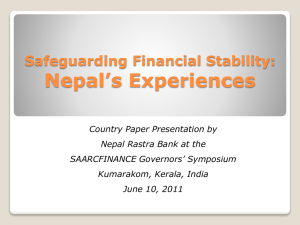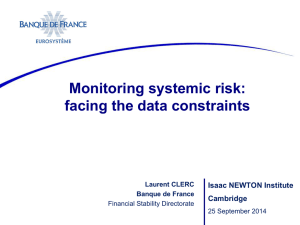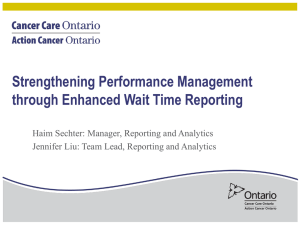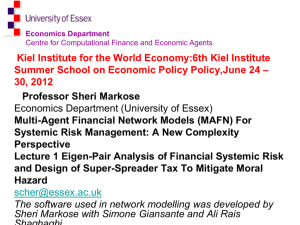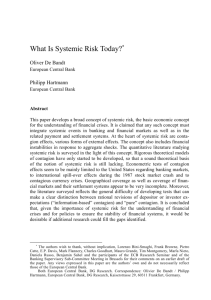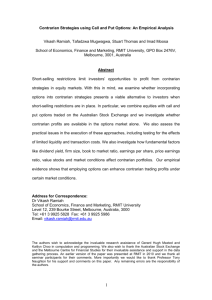submission for the GES which she revised for
advertisement
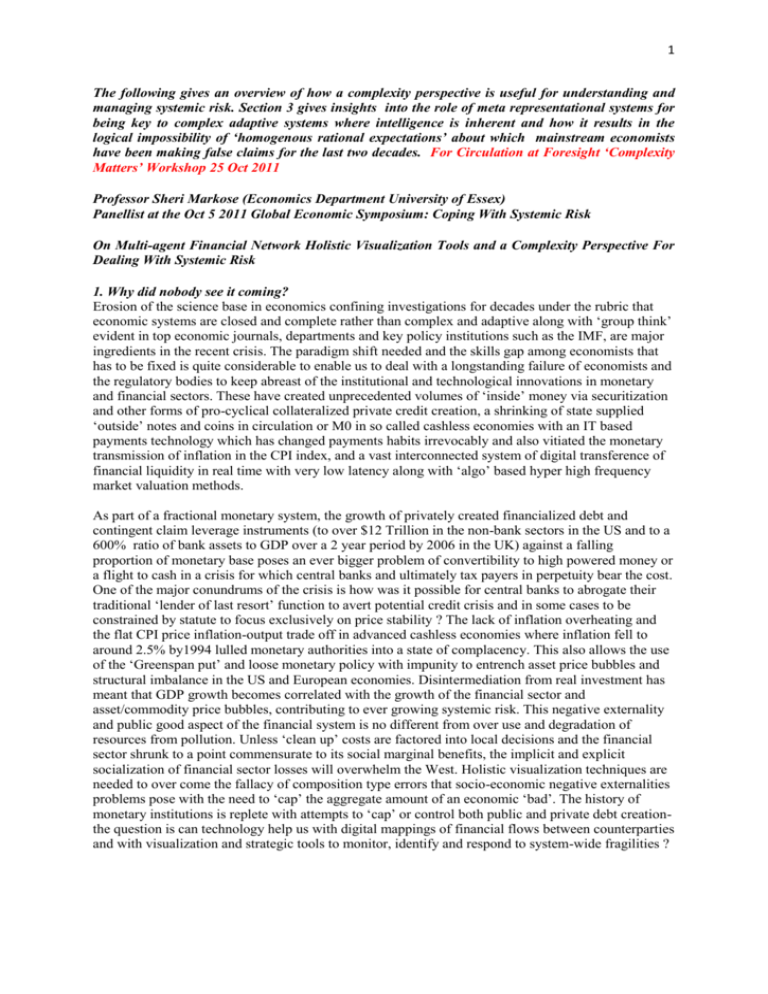
1 The following gives an overview of how a complexity perspective is useful for understanding and managing systemic risk. Section 3 gives insights into the role of meta representational systems for being key to complex adaptive systems where intelligence is inherent and how it results in the logical impossibility of ‘homogenous rational expectations’ about which mainstream economists have been making false claims for the last two decades. For Circulation at Foresight ‘Complexity Matters’ Workshop 25 Oct 2011 Professor Sheri Markose (Economics Department University of Essex) Panellist at the Oct 5 2011 Global Economic Symposium: Coping With Systemic Risk On Multi-agent Financial Network Holistic Visualization Tools and a Complexity Perspective For Dealing With Systemic Risk 1. Why did nobody see it coming? Erosion of the science base in economics confining investigations for decades under the rubric that economic systems are closed and complete rather than complex and adaptive along with ‘group think’ evident in top economic journals, departments and key policy institutions such as the IMF, are major ingredients in the recent crisis. The paradigm shift needed and the skills gap among economists that has to be fixed is quite considerable to enable us to deal with a longstanding failure of economists and the regulatory bodies to keep abreast of the institutional and technological innovations in monetary and financial sectors. These have created unprecedented volumes of ‘inside’ money via securitization and other forms of pro-cyclical collateralized private credit creation, a shrinking of state supplied ‘outside’ notes and coins in circulation or M0 in so called cashless economies with an IT based payments technology which has changed payments habits irrevocably and also vitiated the monetary transmission of inflation in the CPI index, and a vast interconnected system of digital transference of financial liquidity in real time with very low latency along with ‘algo’ based hyper high frequency market valuation methods. As part of a fractional monetary system, the growth of privately created financialized debt and contingent claim leverage instruments (to over $12 Trillion in the non-bank sectors in the US and to a 600% ratio of bank assets to GDP over a 2 year period by 2006 in the UK) against a falling proportion of monetary base poses an ever bigger problem of convertibility to high powered money or a flight to cash in a crisis for which central banks and ultimately tax payers in perpetuity bear the cost. One of the major conundrums of the crisis is how was it possible for central banks to abrogate their traditional ‘lender of last resort’ function to avert potential credit crisis and in some cases to be constrained by statute to focus exclusively on price stability ? The lack of inflation overheating and the flat CPI price inflation-output trade off in advanced cashless economies where inflation fell to around 2.5% by1994 lulled monetary authorities into a state of complacency. This also allows the use of the ‘Greenspan put’ and loose monetary policy with impunity to entrench asset price bubbles and structural imbalance in the US and European economies. Disintermediation from real investment has meant that GDP growth becomes correlated with the growth of the financial sector and asset/commodity price bubbles, contributing to ever growing systemic risk. This negative externality and public good aspect of the financial system is no different from over use and degradation of resources from pollution. Unless ‘clean up’ costs are factored into local decisions and the financial sector shrunk to a point commensurate to its social marginal benefits, the implicit and explicit socialization of financial sector losses will overwhelm the West. Holistic visualization techniques are needed to over come the fallacy of composition type errors that socio-economic negative externalities problems pose with the need to ‘cap’ the aggregate amount of an economic ‘bad’. The history of monetary institutions is replete with attempts to ‘cap’ or control both public and private debt creationthe question is can technology help us with digital mappings of financial flows between counterparties and with visualization and strategic tools to monitor, identify and respond to system-wide fragilities ? 2 2. Data base Driven Multi-Agent Financial Network (MAFN) Models The crisis has shown that extant policy models and quantitative tools are too antiquated for the task at hand. Over reliance by economists on macro-econometric models based on highly aggregated data has impeded progress in the adoption of ICT (Information and Communication Technology) based modelling tools that can build digital simulation platforms from fine grained firm level data bases to monitor and manage systemic risk from complex interconnectedness of market participants and potential perverse regulatory incentives that may exist. While cross sectional statistical models of contagion can be useful, early warning signals such as the Sergoviano and Goodhart (2009) Banking Stability Index based on aggregated market data on CDS spreads were strongly rebutted by Rama Cont and myself at the IMF 2010 Operationalizing Systemic Risk Monitoring Workshop in that they are contemporaneous with the crisis and contain no more information than market indexes such as VIX. With new ICT tools, the mapping of actual financial interconnections to analyse propagation of instability or contagion in the system can be done at a level of granularity and virtual depiction of reality not available in mainstream macro-economics tool box. The fundamental computational methodology for webbased visualization of complex data sets is object oriented programming and multi-agent technology with interconnections between agents modelled as networks. Hence, the acronym MAFN was coined by me. Nodes in a MAFN model represents financial intermediaries (FI for short), other end users and also regulatory authorities and they are imbued with the capacity for rule based behaviour or fully fledged autonomous intelligent behaviour. In a data base driven MAFN, agents and their interconnections are characterized by ‘as is’ quantitative constraints. Network structures are determined as in snap shots of bilateral obligations between counterparties. Both in the characterization of financial interconnections between agents and in terms of agents’ responses, MAFNs are not hampered as equation led macro econometric models are by the need for long time series or panel data. To remedy the lack of empirical work on the network structures of the CDS market, which in particular stands implicated in propagating the 2007 crisis, and also the off-balance sheet derivatives activities of FIs which mediate a large proportion of risk related liquidity provision in the economy, I recently characterized the topological and contagion spreading features of these systems as being too interconnected to fail. The tiered central core of highly interconnected banks is part of a very sparse adjacency and flow matrix for the system. As few as 25 banks account for 99% of the $700 trillion gross notional derivatives market. In terms of financial flows and links in real world financial networks, we have high variance and fat tailed distributions which defy adherence to Nash equilibrium theoretical formulations for network activity. The failure of a highly connected FI will trigger an almost certain failure of other banks in the clustered structure with the contagion coming to an abrupt end when the ‘superspreaders’ have demised. As these banks account for the bulk of capital in the system – ipso facto no bank among the top tier can be allowed to fail highlighting the untenable implicit socialized guarantees needed for these markets to exist at their current levels. Work at the Financial Stability Division of the Reserve Bank of India has been commenced by me (and Simone Giansante) on a MAFN style ICT based model of the Indian financial system. Automated access to both balance sheet and off balance sheet bilateral exposures of bank and nonbank FIs is being facilitated. Reflecting the highly dynamic nature of commercial banking in India, recent changes from one quarter to the next of network connectivity and of banks that over took others in terms of their eigenvector centrality, have revealed a potential HBOS or Northern Rock type situation. At the level of a firm, as in case of Northern Rock and HBOS, aggressive increases in market share which manifests as higher network centrality may appear worthy of awards and accolades. However, holistic modelling tools like network modelling can reveal how this can endanger system stability. The recent RBI Financial Stability Report has given the implicit socialized costs of systemic risk from the failure of these banks to be over 14% of total capital of the Indian banking system. 3 Similarly, for analysis of systemic risk factors in financial markets, the full digital rebuild of the electronic markets are needed. The digital rebuild of the London SETS market at has been undertaken by myself with Azeem Malik ( a Senior Quant at Legal and General and also a PhD student at CCFEA at Essex University). The SETS platform with multi thread for any number of limit order book rebuild for multi stocks has been put through its paces. It is my belief that such fine grained real time simulator of the real market in action is needed to understand the complex structure and dynamics. 3. Complexity Perspective In Macro-economic Policy Design and Strategic Behaviour The mathematical logic of Gödel-Turing-Post that underpins the new science of Complex Adaptive Systems(CAS) has three key components : (i)Meta representational systems and self referential or reflexive mappings that necessitates ' über' computational intelligence of a Universal Turing machine which can execute own and others' codes (ii) Contrarian or self-negating structures like the Liar (as in ‘this is false’) qua rule breaker who can negate what is computable or transparent, and (iii) The consequences of (i) and (ii) is a fundamental incompleteness of the system which can be represented by so called creative and productive sets (see, Smullyan, 1961) with the latter depicting a Red Queen type arms race in novelty production or 'surprises' and structure changing dynamics. The absence of a complexity perspective in game theory and macro-policy design has had far reaching deleterious effects in precipitating this crisis. Firstly, the complexity paradigm shows that claims made for rational expectations equilibria by neo-classical economics are flawed. Brian Arthur et. al. (1994) who pioneered the first agent-based computational economic models used the notion of reflexivity in the context of stock market prices to show that homogenous rational expectations equilibrium is a logical impossibility. Steve Spear (1989) showed that the fixed points representing rational expectations have no computable solutions. Hence, it is a false premise of Thomas Sargent and his acolytes that such fixed points can be learnt recursively minimizing least squared prediction errors and the like. Reflexivity refers to the fact that prices and other social phenomena depend on beliefs or meta-representations of outcomes, and has been popularized by George Soros: “Markets don't reflect the facts very well, partly because they create the facts themselves." Arthur (1994) also noted the inherent contrarian reward structure of asset markets, rewards tend to accrue most to those agents who are contrarian or in the minority, viz. it is most profitable to buy (sell) when the majority are selling (buying). Then, if all agents act in an identical homogenous fashion, they will fail in their objective to be profitable. Hence, heterogeneity in strategies becomes a rational response and endogenous non-predictability of prices and their boom-bust cycles follow not because the system is being buffeted by white noise or ‘news’ but because of activities of agents who can form metarepresentations of the world. Recent advances in neurophysiology of the brain on mirror neurons, hailed as one of the great discoveries in science, gives an explanation for why the capacity for meta-representation with self as an actor in the mapping (leading to the recognition of hostile oppositional intentions) is essential for social and strategic behaviour. V.S. Ramachandran (2006) views Machiavellian behaviour, über intelligence, deceit and creativity as being part and parcel of this capacity of meta-representation. The significance of the mathematical logic of Gödel-Turing-Post is that any system incorporating such elements of self-referential calculation and meta-representatiion will imply incompleteness or in layman’s terms, the capacity to think outside the box and innovate. As early as 1987, Ken Binmore in Modelling Rational Players had pointed out how extant game theory cannot incorporate rule breaking contrarian structures and novelty production. The only indeterminism is randomization between two known actions as the action set is fixed and given. Likewise, the long legacy of the Theil-Tinbergen theory of macro-policy design based on the so called Linear- Quadratic- Gaussian model of optimal control assumes that the policy game is one against nature where policy targets are only buffeted by random noise rather than by intelligent agents who game the system. Though Robert Lucas seminally suggested the necessity of ‘surprises’ in the context of policy effectiveness (albeit in a context of inflation control) this was not seen as the generic need for strategic innovation implementable in an operational way in a game of competitive co-evolution to maintain status quo and stability. For almost two decades the rank and file of macro and monetary 4 economists recommended precommitment to fixed strategies rather than one of co-evolution in policy design (see, Markose, 2005 Sections 3,4 ). First was in the form of currency pegs which were serially destroyed at great cost to the tax payer by the ilk of George Soros (who explicitly cited the Liar strategy). Then, especially in the UK and the ECB, central bankers pursued a fixed quantitative inflation rule within a ritualistic framework that eschewed any attempt to co-evolve with a fast changing monetary and financial environment. While the role of imitation and herding has been emphasized in the build up of crisis, the key architect of complex adaptive systems, the contrarian or the anti-herd, is not sufficiently understood in the bust phase. The role of contrarians in bringing down financial systems should not be underestimated. The prominent contrarian strategies that have netted vast profits in the context of institutionalized free lunches of the ERM currency peg and the CDS bear raid have been, respectively, that of George Soros in 1992 and Paolo Pelligrini and John Paulson in the 2007 crisis. Good institution design should vitiate such opportunities. It is not a coincidence that ‘excessive’ short selling (sometimes identified as excessive insurance taking) with the stock index futures price trading at a 30% discount to the spot in the run up to the 1987 crash is very similar to the excessive short selling in SP-500 futures during the flash crash of 6 May 2010. When the spot and futures equity prices get misaligned with the futures trading at a great discount to the spot, as first pointed out by Stephen Figlewski, all benefits from futures based hedges are undone and the spot market collapse will follow. The short-long arb (going short on the spot market and long in the futures arbitrage) should have kicked in sufficient quantities so that the bubble can burst in small steps over some period rather than in a sharp crash. Shorting stock is known to be hard especially under severe bear market conditions. CFDs (contracts for differences though they have large leverage consequences for equity markets) are meant to have helped improve the shorting of stocks. This must be investigated further and perhaps a circuit brake on excessive futures selling should be considered. Finally, in a remarkable study, Axelrod (2003) cites system failure in networks arises from a situation in which “coevolution is not anticipated”. A regulator-regulatee arms race (cf. parasite-host dynamic) requires monitoring and production of countervailing new measures (cf. production of anti-bodies) by authorities in response to regulatee deviations from rules due to perverse incentives or loopholes in place. Markose (2004, 2005) notes that if the Liar/contrarian or rule breaker cannot be eliminated then the inability of authorities to co-evolve with regulatees will lead to system failure. Thus, a complexity perspective upholds monitoring for perverse incentives and regulatory arbitrage as key for the mitigation of systemic risk and we must avoid “official definitions of systemic risk that have left out the role of government officials in generating it” (Edward Kane). MAFN simulation platforms are well suited to conduct “wind tunnel” tests of policy both prior to implementation and to monitor it on an on-going basis for its capacity to generate race to the bottom type tactics or destabilizing carry trades. References : Arthur, B., Holland, J, LeBaron, B., Palmer, R, Taylor, P,1997, “Asset Pricing under Endogenous Expectations In Artificial Stock Markets”, In The Economy as an Evolving Complex System II, Addison-Wesley. Axelrod , R. (2003) “Risk in Networked Information Systems”, Mimeo, Gerald R. Ford School of Public Policy, University of Michigan. Binmore, K. (1987), “Modelling Rational Players: Part 1”, Journal of Economics and Philosophy, vol. 3, pp. 179-214. Cutland, N.,1980, Computability: An introduction to recursive function theory (CUP). Markose, S. M, (2004), “Novelty in Complex Adaptive Systems (CAS): A Computational Theory of Actor Innovation”, Physica A: Statistical Mechanics and Its Applications, vol. 344, pp. 41- 49. Markose, S. M. (2005), “Computability and Evolutionary Complexity: Markets as Complex Adaptive Systems (CAS)”, Economic Journal, Vol. 115, pp. F159-F192. Ramachandran, V.S, “ Mirror Neurons and imitation learning as the driving force behind "the great leap forward" in human evolution”, Edge Foundation. Retrieved on 2006 November 16. Smullyan, R. (1961) Theory of Formal Systems, Princeton University Press. Spear,S.(1989),“Learning Rational Expectations Under Computability Constraints”, Econometrica 57, 889-910. Segoviano, M and Goodhart, C., “Banking Stability Measures”,IMF, WP/2009/4. Smullyan, R. (1961) Theory of Formal Systems, Princeton University Press.




